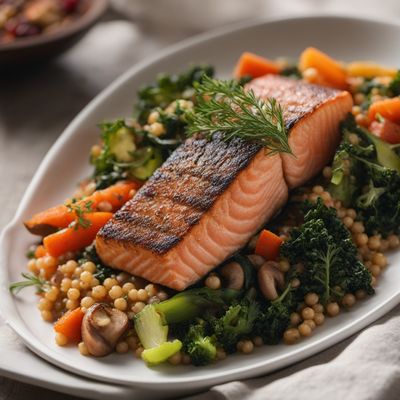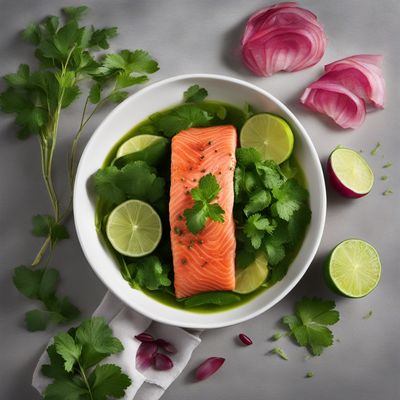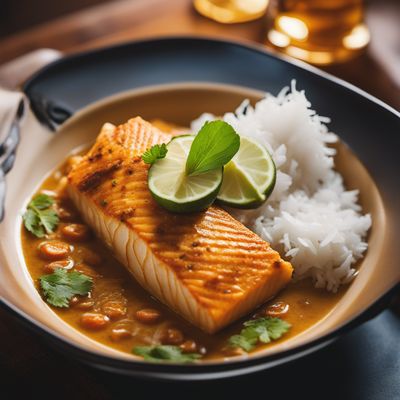
Recipe
Pacific Northwest-inspired Nashi Karē
Wild Salmon Curry with Nashi Pear
4.6 out of 5
Indulge in the flavors of the Pacific Northwest with this delightful twist on the classic Japanese dish, Nashi Karē. This recipe combines the richness of wild salmon with the crisp sweetness of locally sourced Nashi pears, creating a harmonious fusion of flavors.
Metadata
Preparation time
20 minutes
Cooking time
20 minutes
Total time
40 minutes
Yields
4 servings
Preparation difficulty
Easy
Suitable for
Pescatarian, Gluten-free, Dairy-free, Nut-free, Low-carb
Allergens
Fish, Soy
Not suitable for
Vegan, Vegetarian, Paleo, Keto, High-carb
Ingredients
In this Pacific Northwest adaptation of Nashi Karē, we substitute the traditional protein of chicken with wild salmon, a staple of the region. Additionally, we incorporate locally sourced Nashi pears, which add a unique sweetness and texture to the dish. The spices and flavor profiles are adjusted to reflect the Pacific Northwest's culinary traditions, highlighting the region's love for fresh seafood and vibrant produce. We alse have the original recipe for Nashi karē, so you can check it out.
-
1 lb (450g) wild salmon fillets, skin removed and cut into bite-sized pieces 1 lb (450g) wild salmon fillets, skin removed and cut into bite-sized pieces
-
2 Nashi pears, peeled, cored, and thinly sliced 2 Nashi pears, peeled, cored, and thinly sliced
-
1 onion, finely chopped 1 onion, finely chopped
-
2 cloves of garlic, minced 2 cloves of garlic, minced
-
1-inch piece of ginger, grated 1-inch piece of ginger, grated
-
2 tablespoons vegetable oil 2 tablespoons vegetable oil
-
2 tablespoons curry powder 2 tablespoons curry powder
-
1 teaspoon ground cumin 1 teaspoon ground cumin
-
1 teaspoon ground coriander 1 teaspoon ground coriander
-
1/2 teaspoon ground turmeric 1/2 teaspoon ground turmeric
-
1 cup (240ml) coconut milk 1 cup (240ml) coconut milk
-
1 cup (240ml) fish or vegetable broth 1 cup (240ml) fish or vegetable broth
-
2 tablespoons soy sauce 2 tablespoons soy sauce
-
1 tablespoon honey 1 tablespoon honey
-
Salt and pepper to taste Salt and pepper to taste
-
Fresh cilantro, for garnish Fresh cilantro, for garnish
-
Cooked rice, for serving Cooked rice, for serving
Nutrition
- Calories (kcal / KJ): 350 kcal / 1465 KJ
- Fat (total, saturated): 20g, 10g
- Carbohydrates (total, sugars): 15g, 8g
- Protein: 28g
- Fiber: 3g
- Salt: 1.5g
Preparation
-
1.Heat the vegetable oil in a large skillet or wok over medium heat.
-
2.Add the chopped onion and cook until softened and translucent, about 5 minutes.
-
3.Stir in the minced garlic and grated ginger, cooking for an additional minute.
-
4.Add the curry powder, cumin, coriander, and turmeric to the skillet, stirring well to coat the onions and spices.
-
5.Pour in the coconut milk and fish or vegetable broth, stirring to combine.
-
6.Add the sliced Nashi pears and simmer for 5 minutes, allowing the flavors to meld together.
-
7.Gently place the salmon pieces into the curry mixture, ensuring they are submerged.
-
8.Drizzle the soy sauce and honey over the salmon, season with salt and pepper to taste, and gently stir.
-
9.Cover the skillet and simmer for 10-12 minutes, or until the salmon is cooked through and flakes easily with a fork.
-
10.Serve the Pacific Northwest-inspired Nashi Karē over cooked rice, garnished with fresh cilantro.
Treat your ingredients with care...
- Wild salmon — Ensure the salmon is fresh and of high quality. If wild salmon is not available, you can use sustainably sourced farmed salmon as an alternative.
- Nashi pears — Choose ripe but firm Nashi pears for a pleasant crunch in the curry. If Nashi pears are not available, you can substitute them with crisp Bosc or Asian pears.
Tips & Tricks
- For a spicier kick, add a pinch of cayenne pepper or red pepper flakes to the curry.
- Adjust the sweetness by adding more or less honey, depending on your preference.
- Serve the Nashi Karē with a squeeze of fresh lemon juice for a burst of acidity.
- Feel free to add other Pacific Northwest ingredients such as mushrooms or kale to enhance the flavors and textures.
- Leftovers can be refrigerated and enjoyed the next day, allowing the flavors to further develop.
Serving advice
Serve the Pacific Northwest-inspired Nashi Karē over a bed of fluffy cooked rice. Garnish with fresh cilantro for a pop of color and a hint of freshness. Accompany the dish with a side of steamed vegetables or a crisp green salad to complete the meal.
Presentation advice
Present the Nashi Karē in a shallow bowl, allowing the vibrant colors of the curry, salmon, and Nashi pears to shine through. Sprinkle some chopped cilantro on top for an added visual appeal. Serve with a side of rice and a slice of lemon for an inviting and appetizing presentation.
More recipes...
For Japanese cuisine » Browse all
For Pacific Northwest cuisine » Browse all

Vanuatu Coconut Cake with a Pacific Northwest Twist
Pacific Coconut Delight: A Fusion of Vanuatu and Pacific Northwest Flavors

Pacific Northwest-inspired Shaaria with Wild Salmon and Seasonal Vegetables
Wild Salmon Harvest Shaaria: A Taste of the Pacific Northwest

Pacific Northwest Poisson Cru
Ocean Delight: Pacific Northwest Poisson Cru
More Japanese cuisine dishes » Browse all

Yakizakana
Grilled Fish
Yakizakana is a Japanese dish that is made with grilled fish. It is a simple and healthy dish that is often served with a side of rice and miso soup.

Imagawayaki
Imagawayaki is a traditional Japanese sweet that is made from flour, sugar, and eggs. It is a soft, fluffy pancake that is often filled with sweet...

Tonkatsu
Breaded and Fried Pork Cutlet
Tonkatsu is a popular Japanese dish that is made by deep-frying breaded pork cutlets. The dish is typically served with rice, miso soup, and a...
More Pacific Northwest cuisine dishes » Browse all

Lovo
Lovo is a traditional Fijian dish that involves cooking food in an underground oven. It is a communal activity that brings people together to share a meal.

Coconut Fish
Coconut fish is a tropical dish that is made with fresh fish and coconut milk. It is a creamy and flavorful dish that is often served with rice or noodles.

Ahima’a
Ahima'a
Ahima’a is a traditional Polynesian dish that is cooked in an underground oven called an umu. It is a feast dish that is often served at special...





